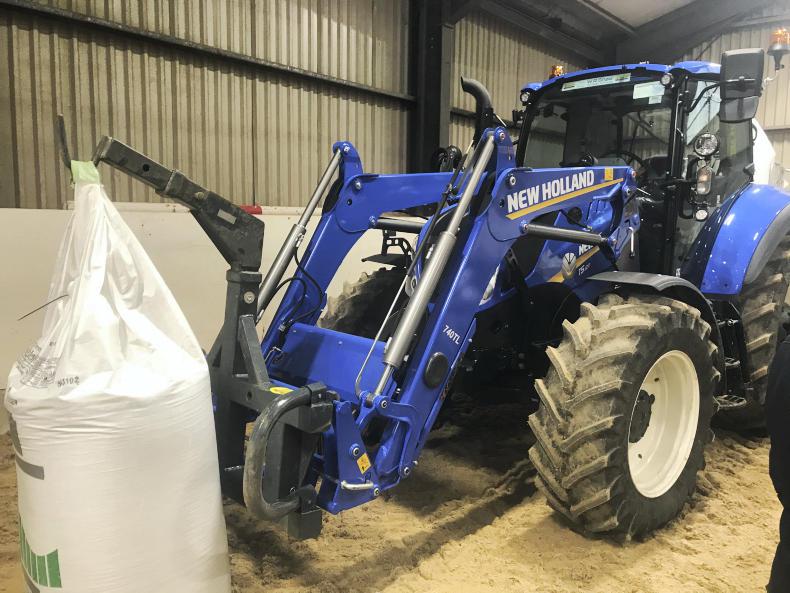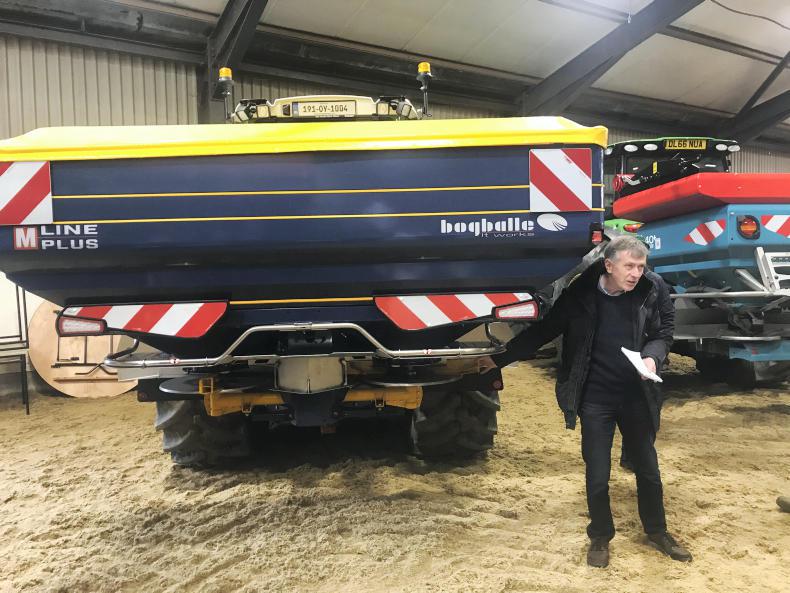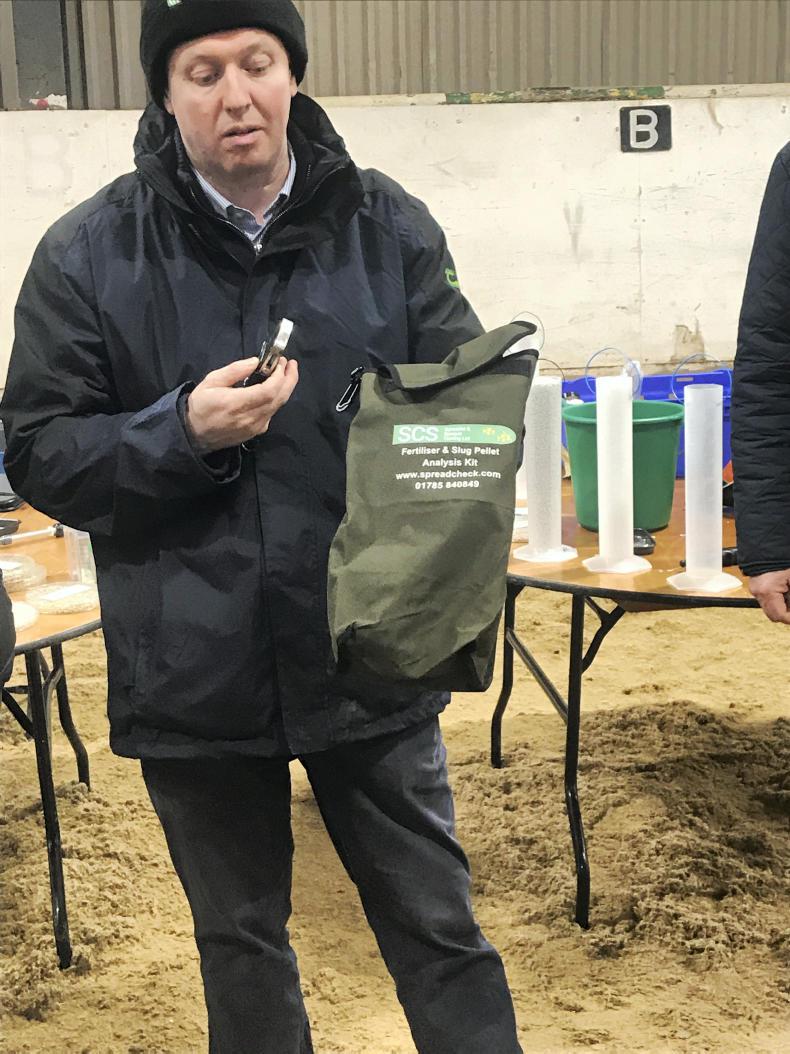Warnings about urea and protected urea were issued at a workshop on the precise application of chemical fertilisers at Gurteen Agricultural College on Wednesday.
The event was organised by the Fertilizer Association of Ireland and Teagasc. Delegates had to register on the Teagasc website in order to attend.

Fertiliser bag lifter on display at the workshop on fertiliser in Gurteen.
The main take-home message from the event was that urea is difficult to spread. Dermot Forristal from Teagasc explained that the density of urea is less than CAN, which makes it difficult to spread at wide bout widths.
Density
“If I have a golf ball and a ping pong ball, both are roughly the same size and the same shape, yet I’d have difficulty throwing the ping pong ball any distance because its density is less, but I could throw the golf ball quite far. It’s the same with urea.” Forristal said.

Dermot Forristal explaining fertiliser spreader settings.
He warned farmers to be careful when purchasing blends with urea in it. He said farmers should ask if the blend has been independently tray tested.
The risk is that the urea will be concentrated in the area near the spreader
“The issue is not so much that the fertiliser won’t travel the required distance. The risk is that the urea will be concentrated in the area near the spreader, while the other products in the compound will be spread further, which could result in striping,” Forristal said.
Urea, while being lower density, has also got a smaller granule size, with potash granules in particular being much bigger. Bigger granules are more likely to travel further.
Characteristics
One of the characteristics of good fertiliser is that 80% of the granules should be of a similar size. A sieve test can be used to check this.
The next issue is granule hardness. Mark Plunkett from Teagasc tested samples of fertiliser for hardness. He found that CAN had a hardness score of 7.5, while urea had a hardness score of only three.

Mark Plunkett displaying a fertiliser testing kit.
John Carroll from Glanbia explained that because urea is softer, there’s a greater risk of it being damaged when it hits the spreading discs.
He says farmers will need to reduce the speed of the discs to prevent granules from being damaged and turning into dust, which drastically reduces the spreading width of the fertiliser.
The Irish Fertiliser Manufacturers and Blenders Association issued guidelines at the event for spreading protected urea.
An advert was also placed in placed in this week’s Irish Farmers Journal advising farmers to take extra precautions when handling protected urea.
According to the flier, which was presented at the station on health and safety, farmers should only work with protected urea in a well-ventilated area.
They should avoid contact with the skin when working with protected urea. The association advises farmers to wear gloves and a face mask when using protected urea. It also advises farmers to wear appropriate eye protection.
Read more
Protected urea: know what you are buying
Limited supply of protected urea
Warnings about urea and protected urea were issued at a workshop on the precise application of chemical fertilisers at Gurteen Agricultural College on Wednesday.
The event was organised by the Fertilizer Association of Ireland and Teagasc. Delegates had to register on the Teagasc website in order to attend.

Fertiliser bag lifter on display at the workshop on fertiliser in Gurteen.
The main take-home message from the event was that urea is difficult to spread. Dermot Forristal from Teagasc explained that the density of urea is less than CAN, which makes it difficult to spread at wide bout widths.
Density
“If I have a golf ball and a ping pong ball, both are roughly the same size and the same shape, yet I’d have difficulty throwing the ping pong ball any distance because its density is less, but I could throw the golf ball quite far. It’s the same with urea.” Forristal said.

Dermot Forristal explaining fertiliser spreader settings.
He warned farmers to be careful when purchasing blends with urea in it. He said farmers should ask if the blend has been independently tray tested.
The risk is that the urea will be concentrated in the area near the spreader
“The issue is not so much that the fertiliser won’t travel the required distance. The risk is that the urea will be concentrated in the area near the spreader, while the other products in the compound will be spread further, which could result in striping,” Forristal said.
Urea, while being lower density, has also got a smaller granule size, with potash granules in particular being much bigger. Bigger granules are more likely to travel further.
Characteristics
One of the characteristics of good fertiliser is that 80% of the granules should be of a similar size. A sieve test can be used to check this.
The next issue is granule hardness. Mark Plunkett from Teagasc tested samples of fertiliser for hardness. He found that CAN had a hardness score of 7.5, while urea had a hardness score of only three.

Mark Plunkett displaying a fertiliser testing kit.
John Carroll from Glanbia explained that because urea is softer, there’s a greater risk of it being damaged when it hits the spreading discs.
He says farmers will need to reduce the speed of the discs to prevent granules from being damaged and turning into dust, which drastically reduces the spreading width of the fertiliser.
The Irish Fertiliser Manufacturers and Blenders Association issued guidelines at the event for spreading protected urea.
An advert was also placed in placed in this week’s Irish Farmers Journal advising farmers to take extra precautions when handling protected urea.
According to the flier, which was presented at the station on health and safety, farmers should only work with protected urea in a well-ventilated area.
They should avoid contact with the skin when working with protected urea. The association advises farmers to wear gloves and a face mask when using protected urea. It also advises farmers to wear appropriate eye protection.
Read more
Protected urea: know what you are buying
Limited supply of protected urea









 This is a subscriber-only article
This is a subscriber-only article










SHARING OPTIONS: